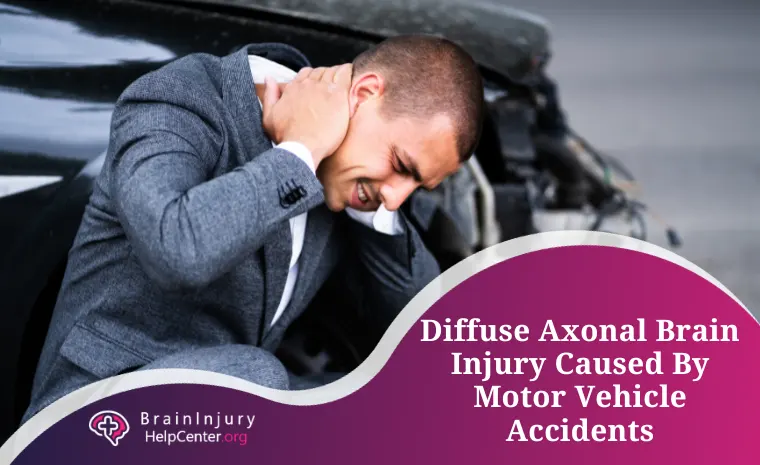Motor vehicle accidents (MVAs) can be life-altering events that result in a wide range of injuries, both visible and hidden. One of the most severe and often overlooked injuries associated with MVAs is diffuse axonal brain injury or DABI.
In this blog post, we will explore what DABI is as a result of an MVA and dig deep into the legal implications challenges involved in proving such injuries in court, and the compensations victims may be entitled to.
Suffered from severe head injury due to a car accident?
Understanding Diffuse Axonal Brain Injury
DABI is a traumatic brain injury that occurs when the brain’s axons are sheared, torn, or damaged due to rapid acceleration and deceleration forces, which are common in high-impact MVAs. Axons, which are the long, slender nerve fibers responsible for transmitting electrical signals between neurons, from the brain to the spinal cord. These are crucial for the proper functioning of the nervous system, and their disruption can lead to a cascade of neurological issues.
In high-impact MVAs, the forces at play during rapid acceleration and deceleration can cause the brain to move within the skull. This movement can lead to the stretching and tearing of axons, particularly in areas of the brain where white matter is abundant. White matter consists of bundles of axons covered in a myelin sheath, which acts as an insulating layer for efficient signal transmission. When white matter is damaged in DABI, it disrupts the neural connections and communication between different regions of the brain.
As a result of the axonal injury, intracranial pressure can rise, further exacerbating the damages, leading to reduced blood flow and oxygen supply to nerve cells and additional neurological deficits.
The Adams Classification for Diffuse Axonal Injury
Grade 1: Mild injury showing faint microscopic brain cell changes in the gray matter (cerebral cortex), corpus callosum (white matter), and brainstem.
Grade 2: Moderate injury, marked by distinct focal abnormalities within the corpus callosum.
Grade 3: Severe diffuse axonal injury, demonstrating the features observed in Grade 2, alongside additional focal lesions found in the brainstem.

Signs and Symptoms of DABI
Unlike focal brain injuries that affect a specific area, this axonal injury is characterized by widespread damage throughout the brain, often leading to various symptoms. The severity of these symptoms can vary depending on the extent of the axonal injury.
Here is a list of common signs and symptoms associated with DABI:
- Loss of consciousness that ranges from a few seconds to an extended period
- Confusion and disorientation
- Persistent and severe headache
- Nausea and vomiting, especially in the immediate aftermath of the head injury
- Dizziness and balance problems
- Difficulty speaking
- Weakness or paralysis in various parts of the body
- Blurred vision, double vision, or difficulty focusing on objects
- Sensory changes, including numbness or tingling in the extremities
- Seizures
- Cognitive impairments, including memory problems, reduced attention span, and difficulty with problem-solving and decision-making
- Behavioral changes, such as personality changes, mood swings, and altered behavior
- Insomnia or excessive sleepiness
- Coma, verbal and motor response of 6
The signs and symptoms of DABI can evolve and change over time, and some may become more apparent as the brain injury’s full impact becomes clear. Because DABI can be challenging to diagnose and manage, individuals who are suspected to have severe brain injury, especially after a motor vehicle accident, must seek immediate medical attention if they suspect a brain injury.
Diagnosis of DABI
Diagnosing DABI can be challenging because it often involves microscopic damage to axons that may not be visible on conventional imaging tests like CT scans. However, certain diagnostic tests are crucial in identifying and assessing the extent of the axonal injury. These tests include:
- Magnetic Resonance Imaging (MRI): MRI is one of the imaging modality of choice for diagnosing DABI. Unlike CT scans, MRI can capture detailed images of the brain’s white matter and detect microstructural damage to axons. Diffusion tensor imaging (DTI), a specialized MRI technique, can provide information about the integrity of white matter tracts.
- Computed Tomography (CT) Scan: While not as sensitive as MRI for detecting DABI, CT scans are still essential in the initial assessment in cases of a closed head injury. They can help identify other potential issues such as hemorrhages or skull fractures.
- Neuropsychological Testing: Neuropsychological assessments are crucial for evaluating cognitive functions, memory, attention, and other aspects of brain function. They help establish the extent of cognitive impairment due to severe brain injuries, which may reflect on the victim’s motor and verbal response.
- Electroencephalogram (EEG): EEG measures electrical activity in the brain and can help identify abnormal patterns associated with seizures or other neurological problems, which can occur in DABI cases.
- Cerebral Angiography: In cases of severe DABI or when vascular injuries are suspected, cerebral angiography may be used to visualize the blood vessels in the brain.
- Intracranial Pressure Monitoring: Monitoring intracranial pressure is crucial for assessing the risk of elevated pressure, which may require immediate intervention.
Legal Implications of DABI in MVAs
When DABI occurs as a result of a motor vehicle accident, it carries significant legal implications for both the victims and the at-fault parties. Personal injury law is designed to protect the rights of accident victims and ensure they receive fair compensation for their injuries. Here’s how DABI intersects with personal injury law:
- Liability Determination: Proving liability in MVAs involving DABI can be complex. Insurance companies and legal teams often dispute fault, which can delay the compensation process. It is crucial to gather evidence, such as accident reports, eyewitness testimonies, and expert medical opinions, to establish liability.
- Medical Documentation: Establishing the extent and impact of DABI requires comprehensive medical documentation. Victims may need neuropsychological assessments, imaging test results, and treatment records to prove the severity of their injuries. This documentation is essential for calculating compensation.
- Compensation: Victims of MVAs resulting in DABI may be entitled to various forms of compensation, including medical expenses, lost wages, pain and suffering, and long-term care costs. These damages aim to help victims regain their quality of life and cover ongoing expenses.
- Statute of Limitation: The statute of limitations is a legal time limit within which a victim must file a lawsuit to seek compensation for their injuries. The specifics of these time limits can vary from state to state and may depend on the circumstances of the accident and the injuries sustained. In California, statute of limitation is two years from the time of injury.
Diagnosed with DABI from a car crash?
Challenges in Proving DABI
Proving DABI in court can be challenging due to the invisible nature of the injury and the need for expert testimony. Insurance companies may attempt to downplay the severity of the injury or dispute its causation.
When pursuing a personal injury claim after experiencing DABI as a result of a car accident, gathering strong evidence is crucial to strengthen your case and maximize your chances of receiving fair compensation. Here are several types of evidence that can be particularly impactful to strengthen your claim:
- Accident Reports: Official accident reports filed by law enforcement officers can provide an objective account of the accident’s details, including the date, time, location, weather conditions, and any statements made by the involved parties.
- Eyewitness Testimonies: Statements from individuals who witnessed the accident can be powerful evidence. Eyewitnesses can describe the events leading up to the crash, the actions of the parties involved, and the immediate aftermath.
- Medical Records: Comprehensive medical documentation is essential in demonstrating the extent and impact of your DABI. This includes records of hospital admissions, emergency room visits, diagnostic tests (e.g., MRIs, CT scans), surgical procedures, and ongoing treatments (e.g., speech therapy, physical therapy, pain treatments).
- Expert Medical Opinions: Testimony from medical experts, such as neurologists or neuropsychologists, can provide critical insight into the clinical findings and long-term consequences of your DABI, especially if there is permanent disability due to the accident.
- Photographs and Videos: Visual evidence, including photographs and videos, can be compelling. These visuals can depict the accident scene, vehicle damage, road conditions, and visible injuries. They can help recreate the circumstances of the accident for the court.
- Witness Statements: Statements from individuals who know you personally can be valuable in describing any changes in your behavior, personality, or cognitive abilities following the accident. These statements can highlight the impact of DABI on your daily life.
- Employment Records: If you were employed at the time of the accident and have experienced a loss of income or the inability to work due to your injuries, employment records, pay stubs, and documentation of missed workdays can establish economic damages.
- Journal or Diary Entries: Keeping a personal journal or diary detailing your recovery process, symptoms, and daily challenges can provide a candid and chronological account of your experiences, which can be persuasive in court.
- Accident Reconstruction: In complex cases, accident reconstruction experts can recreate the accident using scientific methods. They can testify about factors such as vehicle speed, impact angles, and the dynamics of the collision.
- Past Medical History: Documentation of your pre-existing medical conditions and medical records from before the accident can help establish that your diffuse axonal brain injury and related symptoms were a result of the accident.
- Prescription Records: Records of medications prescribed for pain management, treatment of symptoms, or other medical needs related to your DABI can serve as evidence of your injury’s severity.
- Documentation of Rehabilitation: Records of rehabilitation sessions, therapy sessions, and progress reports can demonstrate your commitment to recovery and the ongoing challenges you face.
To maximize the strength of your diffuse axonal injury lawsuit or claim, it’s advisable to consult with a skilled personal injury attorney with experience in handling traumatic brain injury cases. They can help you gather, organize, and present this evidence effectively in court and guide you through the legal process. A legal team can help ensure that you receive fair compensation for your DABI-related damages.
Conclusion
Diffuse axonal brain injury (DABI) is a severe consequence of motor vehicle accidents that can have life-altering consequences for victims. Understanding the legal implications and challenges associated with DABI is crucial for accident victims seeking fair compensation.
While every case is unique, gathering strong evidence, securing expert testimony, and working with experienced personal injury attorneys are essential steps in the pursuit of justice for DABI victims. The legal system plays a vital role in ensuring that those affected by DABI receive the support and compensation they need to rebuild their lives.
If you or a loved one has suffered a brain injury following a car accident, it is best to consult with a legal professional experienced in personal injury cases.
The Brain Injury Help Center can help you connect with a team of medical experts and personal injury lawyers who can help you get financial compensation for your injury and suffering while going through your treatment and recovery.
Call us at (866) 576-0936 for a free consultation.









